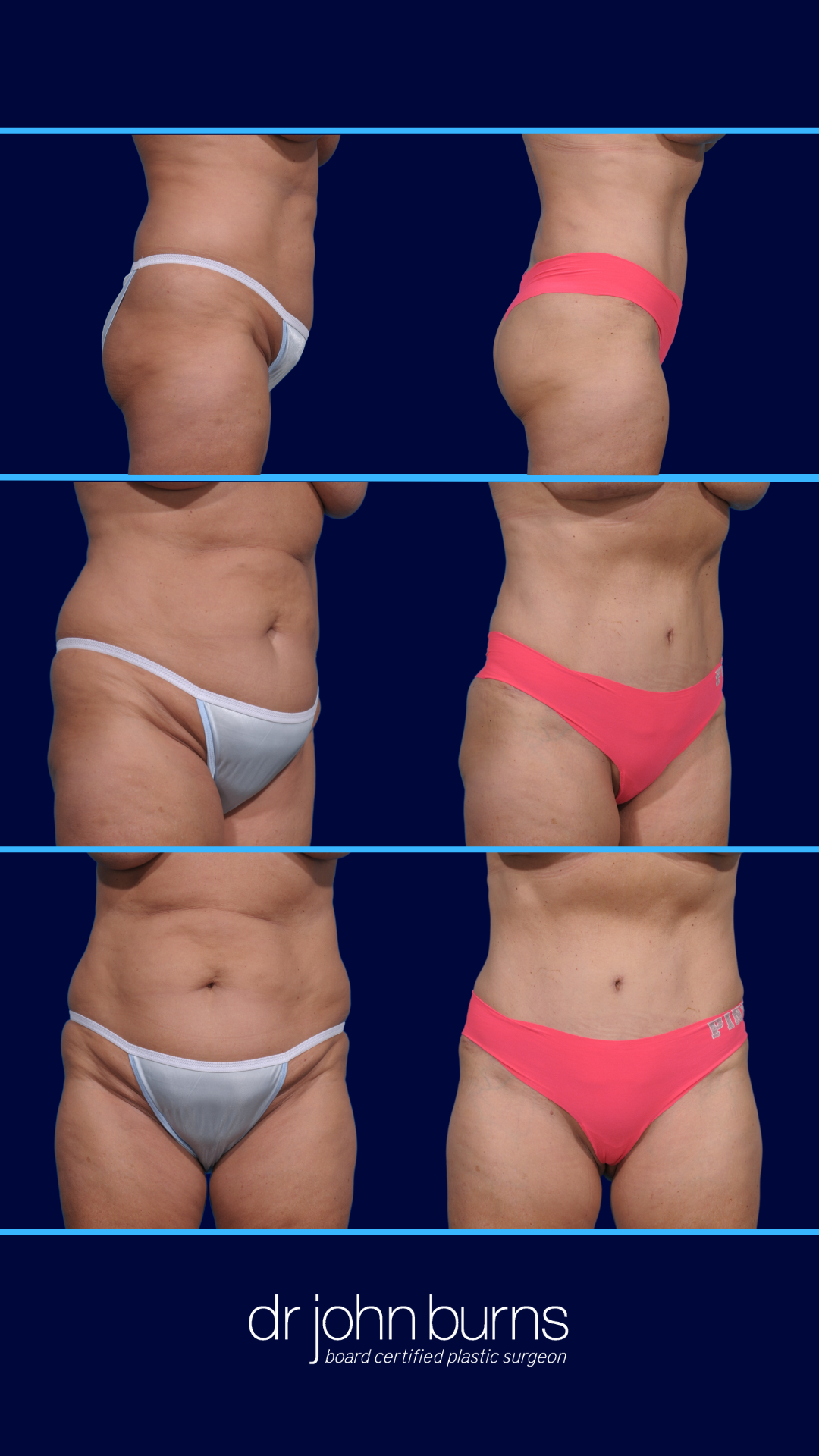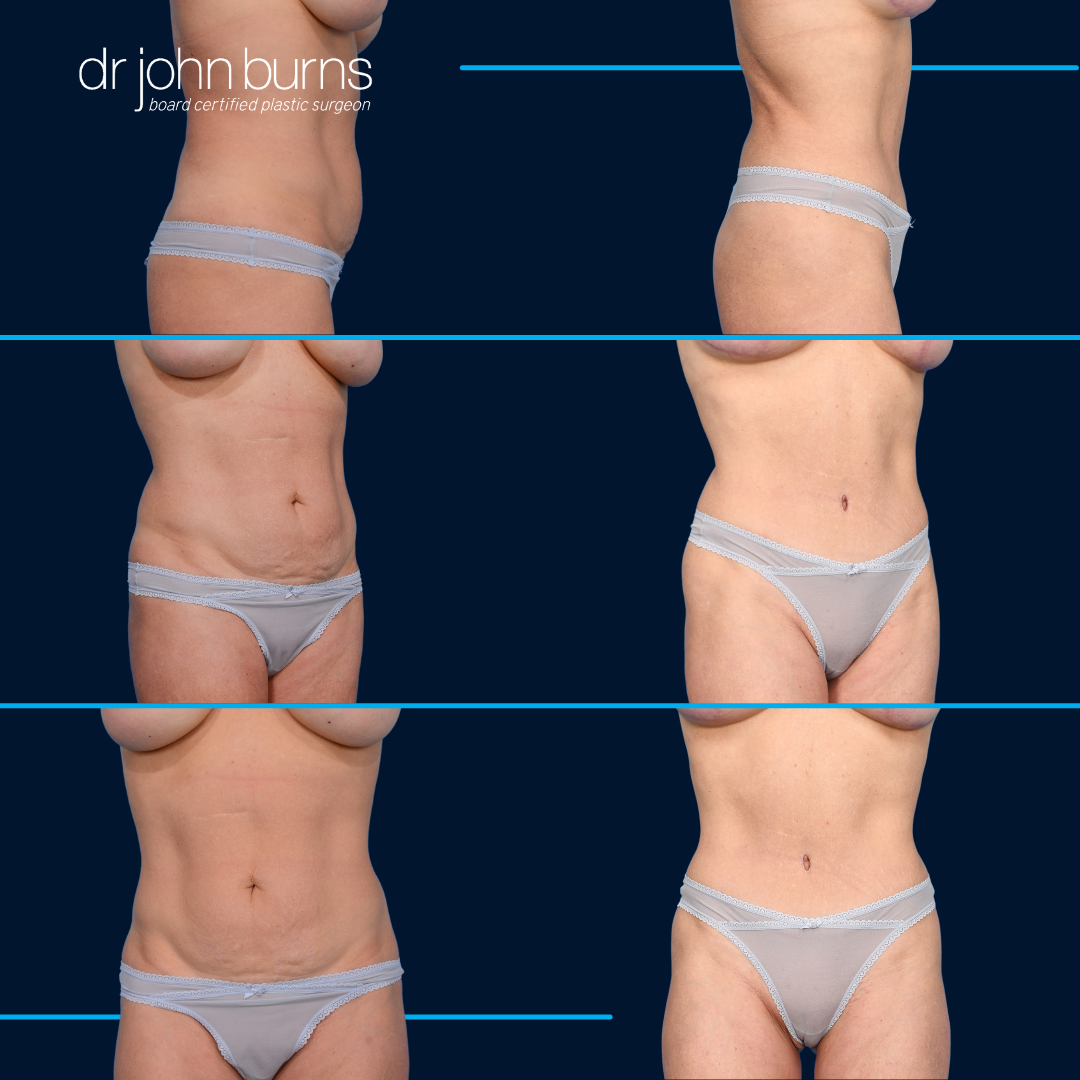April 2024
What Is Diastasis Recti, And How Can
Tummy Tuck Surgery Help?
What Is Diastasis Recti?
Diastasis recti or rectus diastasis is the stretching of the rectus abdominis muscles that are centrally located in the abdomen and run from your rib cage to your pubic area. These muscles are the “six-pack” muscles you develop with exercise.
With the expansion of the abdominal wall muscles, there can be a separation between the rectus muscles called diastasis. The muscles are joined in the middle with fascia. The fascia stretches so that the muscles bow string out and to the sides. This is common with excessive weight gain and pregnancy. This gives a rounded appearance to the abdomen and loss of an hourglass shape. The abdominal protrusion is often especially noticeable for moms, and they'll come to us after noticing it at the gym or while wearing form-fitting clothing.
Rectus diastasis is not something that can be cured with diet and exercise. By surgically repairing the stretched-out fascia, then and only then, will the abs be flat again.
Problems Women Experience with Diastasis Recti
Tummy Bulging
The loose muscles cause several cosmetic problems. First, on the side profile, the abdomen tends to bulge or press outward due to the lack of muscle support. This creates a round abdomen and not the desired flat appearance.
From the front view, the waist will appear straight and not curved or hourglass-shaped as is more common with female anatomy. Pulling the muscles inward to the middle pulls the waist inward giving an hourglass shape. In my practice, I use a corset technique where both the middle and sides of the abdomen are plicated or sutured to give an even tighter waist.
Read More: Corset Tummy Tuck: Three-vector Plication For A Tighter Waist
Lower Back Pain
Rectus diastasis can also result in lower back pain and poor posture. The torso is a delicate balance between the front and back muscles. With rectus diastasis the abdomen is weaker thus the lower back assumes more role in support. This can result in undue pressure on the lower back and ultimately lower back pain or discomfort. Fixing the rectus muscles realigned and strengthens them thereby redistributing the muscle balance between front and back. In most cases, this improves the lower back pain for many women who silently struggle.
Incontinence
In women who experience a loose abdominal wall, the bladder is not as stabilized and can move causing problems with urinary incontinence. Tightening the abdominal wall will better support and position the bladder back into its proper anatomic position thus improving urinary incontinence.
How Common is Diastasis Recti?
There will always be some degree of rectus diastasis with pregnancy. The amount of diastasis depends on many factors such as the size of the patient, the number of previous pregnancies, strength of the abdominal muscles, obesity, and general overall health. In almost all cases, rectus plication should be part of any tummy tuck procedure.
Read More: The Tiny Tummy Tuck: Mini Tummy Tuck with Major Benefits
Read More: The Tiny Tummy Tuck: Special Considerations
Tummy Tuck Before and After by Dr. John Burns MD in Dallas, Texas



How Do I Know If I Have Diastasis Recti?
If you’ve had a pregnancy or lost a large amount of weight you’ll have some degree of rectus diastasis. A good test is to relax your abdominal muscles and view yourself from the side. If you have rectus diastasis your abdomen will bow outward and then improve with abdominal muscle contraction. Another good test is a straight leg raise. Lie flat and try to lift both legs off the ground in a straight position. You will feel your abdominal muscles tighten and you can feel the amount of abdominal muscle separation between the muscles when you are flexing the muscles. Many patients define their rectus diastasis by the number of fingers they can fit between the muscles when they flex.
How Is Diastasis Recti Repaired?
The recti diastasis, or separation, is repaired by sewing the muscles together in the midline. The sutures run from the ribcage to the pubic area stopping at the umbilicus or belly button and then starting back up from the umbilicus to the pubic area. The plication or repair is done in 2 layers for reinforcement and insurance. The first layer is interrupted sutures and the second is done in a running or continuous fashion. The 2 layer closure is extremely strong and stands up well over time.
In some cases, there is additional laxity of the abdominal wall muscles. In those instances, I do a corset plication where I tighten the lateral areas called the oblique muscles. This further tightens the waist inwards giving even more of an hourglass shape.
Read More: The Dallas Tummy Tuck
What Are The Results of A Tummy Tuck with Abdominal Muscle Repair?
The tummy tuck removes skin and fat from the belly button to the pubic area. The plication part of the procedure further flattens the abdomen and brings the waist in. Finally, 360 liposuction is used to remove unwanted fat from areas like the waist, upper abs, flanks, love handles, underarms, and back. This gives a 360 result, sculpting and shaping the entire midsection.
Read More: VASER® Liposuction Different: High-Definition Body Contouring
What Will My Scars Look Like After Diastasis Repair?
The diastasis repair is performed internally so there are no scars with the actual muscle repair. That said, there will be an incision from hip bone to hip bone across the lower abdomen to allow access to the underlying muscles and to remove excess skin and fat. This incision is placed low on the abdomen, a bikini incision, so that it is covered with underwear or a bikini bottom.
Can You Treat Diastasis Recti Without A Tummy Tuck?
No, you have to see the rectus abdominis muscle to sew it together. In addition, you have to fully release the soft tissue off of the muscles before you sew them together or it would bunch up the abdominal skin and soft tissue.
What Is The Recovery Time Like?
Dr. Burns uses a long-lasting numbing medication called Exparel which numbs the abdomen during the early stages of recovery. (Link to Exparel blog). This greatly reduces the need for oral pain medication and makes the first several days much more comfortable for women.
The first week is spent at home recovering. Activities of daily living are fine, and patients are encouraged to walk every hour or so to prevent blood clots. Most patients can drive 1 week after surgery, provided they are off all pain medication. Light exercise is usually resumed at 1 month with full return to regular exercise in 3 months.
Tummy Tuck Before and After by Dr. John Burns MD in Dallas, Texas




Get Started With Board-certified Plastic Surgeon, Dr. John Burns MD
If you've been researching abdominal rejuvenation and tummy tuck surgery, we invite you to schedule a complimentary in-office or virtual consult with Dr. John Burns MD.

Dr. John Burns in Dallas, TX, employs both artistry and skill in using advanced techniques that go beyond mere surgery – he specializes in creating results that are natural yet transforming.
Our team is curated to provide you with passionate and compassionate care throughout your journey. We are your advocates for a beautiful outcome that you will enjoy for years. Click the button below to get started with Dr. Burns and his team.
D Magazine: Ask The Mommy Makeover Expert
D Magazine: The Face of Breast Augmentation
You May Also Like
Capsular Contracture After Breast Augmentation | Dr. John Burns
Motiva Silk Surface Implants Explained | Dr. John Burns Dallas
Holiday Beauty Guide 2024–2025 | Dr. John Burns & JOLA DALLAS
Top Aesthetic Trends of 2025 | Dr. John Burns Plastic Surgery Dallas
Stay In Touch
Follow us for news and information on plastic surgery procedures





